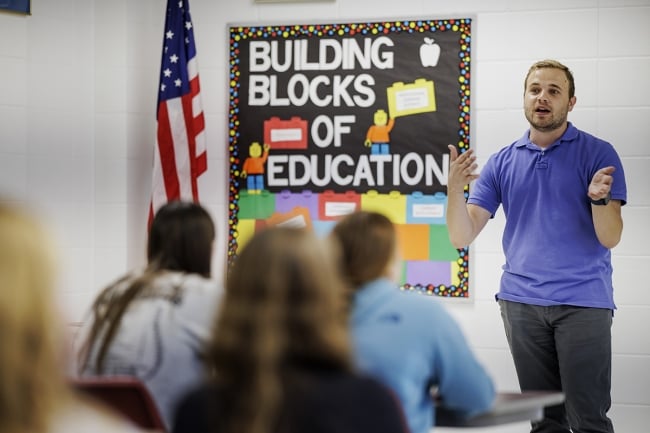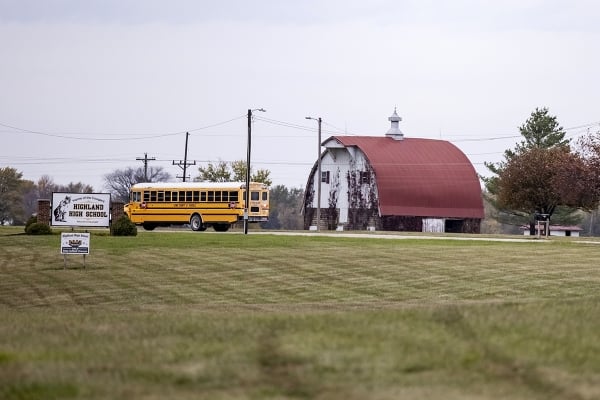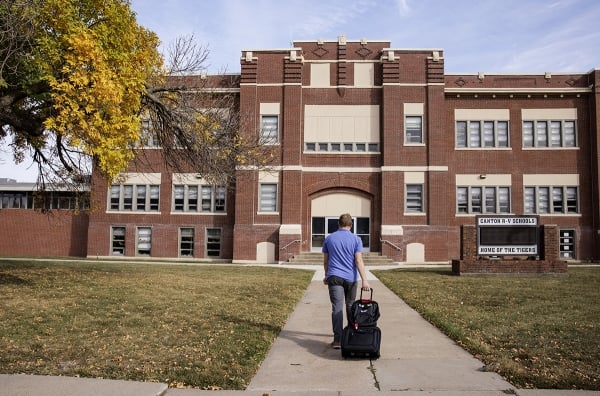You have /5 articles left.
Sign up for a free account or log in.

Dacoda Scarlett (right), associate director of the Heartland Initiative, tells a group of rural high school students about the opportunities at Washington University in St. Louis.
Washington University in St. Louis
Miah Bressie, a high school senior from a small town in south-central Missouri, had barely heard of Washington University in St. Louis—let alone considered applying—until a student in the graduating class ahead of hers was accepted last fall.
Nestled in the rolling hills of the Ozarks, Bressie’s blue-collar hometown, Houston, has a median income of $40,893 and a bachelor’s degree attainment rate of just 14.5 percent. So for Bressie and many of the other 70-some students in her graduating class, attending a selective, private institution like WashU was seen as out of reach.
But then an admissions representative from WashU showed up at the Houston High School college fair last fall, and Bressie’s outlook changed. That visit “locked in” her decision to apply, she said.
“Some local colleges usually come, but none as prestigious as WashU. It was really cool to see them there,” she said. “Now there’s posters hanging up around our school advertising it, and I have my counselor forwarding me every WashU email she gets.”
Bressie isn’t the only student whose outlook was transformed by meeting with WashU admissions officers. In September and October alone, recruiters from the university logged nearly 10,000 miles—the equivalent of 20 round trips between St. Louis and Kansas City—traveling to 80 high schools in small towns across Missouri and southern Illinois, according to The Source, a WashU online news publication.
The high school visit hyperdrive is part of a renewed push by the university to increase college accessibility for low-income students from rural areas. Known as the Heartland Initiative, the campaign also features a new summer college prep program called the Rural Scholars Academy and a series of campus “fly-ins” and free workshops to support counselors at rural high schools.
Expanding socioeconomic representation among the student body first became a priority for WashU nearly a decade ago, when the university was named one of the nation’s least economically diverse colleges. The push has paid off; WashU increased its proportion of low- and moderate-income first-year students from 6 percent in 2014 to 16 percent in September. But college leaders are looking to improve more.
“There’s an untapped market with rural students across the country—talented, educated, passionate students—who we, as a field, just aren’t doing a good job of reaching out to,” said Dacoda Scarlett, associate director of the Heartland Initiative.
WashU decided to start reaching out to prospective students close to home as a way to give back to the community; in Missouri, more than 45 percent of public schools are located in rural areas or small towns.
“We are WashU in St. Louis, for St. Louis and of St. Louis,” Scarlett said. “And that includes not just the city and the county but also the two states that we are in, or border, Missouri and southern Illinois.”
So far, the campaign is showing signs of success. For the 2022–23 academic year—before the Heartland Initiative was launched—the university enrolled 23 first-year students from rural Missouri and southern Illinois, out of a class of about 1,850. In 2023–24, that number increased to 31. And for the class set to enter this fall, 21 rural first-year students were admitted in the first round of early-decision acceptances in December.
Bressie is excited to be one of them. She plans to study biology at WashU starting next fall.
“I didn’t have super high hopes going into it … It was emotional for sure,” she said. “If you’re coming from a small school, there’s not as many resources. That makes you seem like a less qualified applicant, but in reality, you’re often just as qualified.”
A Growing National Focus
Nontraditional college recruitment campaigns that target underrepresented populations are popping up across the country as higher ed leaders simultaneously prepare for a daunting enrollment cliff, respond to policy makers’ call for higher levels of degree attainment and seek new ways to maintain diversity in the wake of the Supreme Court’s ban on affirmative action in admissions.

Only 59 percent of rural residents go on to college directly after high school, compared to 67 percent of urban ones.
Washington University in St. Louis
Bressie believes that “more colleges should take notes” on WashU’s efforts to attract rural students—and they are.
WashU was one of 16 institutions that in April teamed up to establish the Small Town and Rural Students College Network, or STARS. Participants include other highly selective institutions such as the Massachusetts Institute of Technology and Columbia University, as well as public colleges like Ohio State University and the University of Maryland.
Courtney Brown, vice president of strategic impact for the Lumina Foundation, said that for some institutions—especially those struggling to maintain enrollment—the incentive for expanding rural outreach is both financial and philanthropic.
“They need to reach beyond who they traditionally have been reaching out to, both so they can stay open and so they continue pursuing their mission,” Brown said. “States are really focused on reaching their own attainment goals; they’re asking their public institutions to rethink what initiatives can help students who have been disadvantaged access postsecondary education.”
Rural students represent a large, untapped market for colleges seeking to boost enrollment and increase diversity. Data from the National Center for Education Statistics show that only 59 percent of rural residents go to college directly after high school, compared to 67 percent of urban ones. And even fewer complete a degree; in 2021, only 21 percent of rural residents age 25 and older held at least a bachelor’s degree, according to the U.S. Census Bureau, falling well below the 36 percent of the nonrural population.
“Rural students are not a monolith. Whether it’s Black communities in [the] rural Southeast or Latinx communities in rural Texas … there are rural students of color that aren’t being given the time of day when it comes to college access,” said Scarlett. “So for us, diversity has expanded to include the rural demographic.”
Marjorie Betley, executive director of STARS and a senior admissions officer at the University of Chicago, said the concept of rural recruitment isn’t new, but it has received a fresh burst of interest. The 2016 presidential election, and the deep political polarization it revealed between rural and urban regions, was a “crucible” for reinvigorated recruitment efforts, she said.
“Admissions officials were kind of like, ‘Oh, we are not reaching these students the way that we should be,’” Betley added. “‘We don’t have their voices, perspectives and lived experiences represented on campus.’”
Reversing ‘Misconceptions’
WashU’s Scarlett noted that the urban-rural divide existed long before the 2016 election, but many colleges and universities shied away from addressing it.
“Now, a lot of schools are having to really overwork and overcompensate to bridge that divide and not be seen as these liberal, elite bastions in these big urban cities,” he said.

Dacoda Scarlett enters Canton High School in rural northeastern Missouri, one of many stops he made this fall as part of the Heartland Initiative.
Washington University in St. Louis
But Scarlett, who grew up in rural southwestern Missouri, said that one of the biggest challenges in narrowing the gap is ensuring that rural residents, especially those who are politically conservative, feel a sense of belonging. That starts with institutions highlighting the range of clubs and organizations available to students of all identities and ensuring the protection of free speech, he added.
“We’re not going to change who we are as institution drastically enough to really change our student body from leaning left to leaning right,” he said. “But by at least going and showing these students that WashU is an option for them, they can make the choice if WashU is a great place for them.”
Mary Worthington, the college and career adviser at Hannibal High School in Hannibal, Mo., said that even as a longtime educator, she has conceived of selective institutions as unaffordable and reserved for the “geniuses” of the world.
“I feel like my misconceptions would probably be a lot of people’s misconceptions,” she said.
Hannibal High School—located in a town of about 17,000 along the Mississippi River two hours north of St. Louis—didn’t even have a college adviser until last year, when Worthington accepted the position, funded partly by the district and partly by a rural equity nonprofit called rootEd Alliance.
When Scarlett visited Hannibal as part of the Heartland Initiative, Worthington learned that the top 10 percent of each graduating class could be candidates for admission to WashU.
He also told her about two new financial aid programs to offset the university’s estimated $83,760 annual price tag. The WashU Pledge, introduced in 2019, covers the full cost of attendance for Pell-eligible rural students, and a no-loan policy, adopted in September, guarantees that all financial aid given, regardless of income, will take the form of grants.
“Financially and academic-wise, it seemed unreachable to the average kid in a small town like Hannibal, Missouri, but it’s not. It’s not at all,” Worthington said.
Scarlett noted that rural recruitment efforts are more costly and time-consuming than those in urban and suburban regions, where admissions representatives can visit three or more schools in a day and meet dozens of students at each. So sharing information and building rapport with counselors like Worthington is crucial, he said.
“One student that I interact with is one student, but one counselor is going to get to hit every student in their school,” he said.
Spreading a Positive ‘Contagion’
Scarlett hopes that as the rural population at WashU grows, momentum will build.
Like Bressie, Sierra Milligan from Fulton, Mo., said WashU wasn’t on her radar at first. Her high school, located just 30 minutes south of the University of Missouri, had limited college prep resources available, so she had to coach herself through the application process.
Now a junior at WashU and a member of the new Rural Student Ambassador program, Milligan hopes to ensure that other applicants don’t have the same experience.
“Getting that opportunity to open the door and say, ‘Hey, I know people aren’t talking about this at your school, but that doesn’t mean that it’s not an option for you,’ is so amazing,” she said.
Some high school leaders are hesitant about programs like the Heartland Initiative, fearing a kind of brain drain in which their best and brightest graduates will leave town and not come back to help lead the next generation.
But Worthington said that in the end, increasing college accessibility will have the better return on investment by creating a form of positive “contagion.”
“Your world is bigger than your small town that you live in. And if you don’t grow and change, your town doesn’t get bigger and better and more competitive with business and industry,” she said. “So to me, the more individuals that are getting educated and growing, that’s better for your town to be able to grow as well.”




